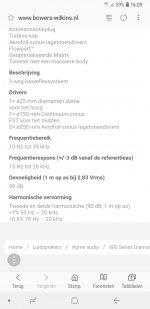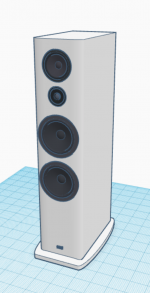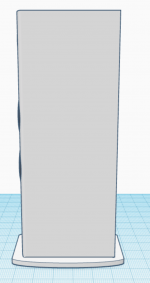Thanks for your advice. I know practicing is the best way to achieve things but I just don't really have the time for making multiple little speakers all the time.
About handing the crossovers to someone else. I have asked Ruud from speakerland.nl if he could help me and maybe build the crossovers with/for me. He also is quite a legend and has decades of experience. He's like the Dutch Trials Gravesen but the guy you pointed to me seems even better. Those speakers he has on his website look amazing! I'm gonna ask if he could help me. I actually only asked Ruud a rough estimation of what he thinks will be the cost for my crossovers.
About handing the crossovers to someone else. I have asked Ruud from speakerland.nl if he could help me and maybe build the crossovers with/for me. He also is quite a legend and has decades of experience. He's like the Dutch Trials Gravesen but the guy you pointed to me seems even better. Those speakers he has on his website look amazing! I'm gonna ask if he could help me. I actually only asked Ruud a rough estimation of what he thinks will be the cost for my crossovers.
The guy from humble... said it was gonna be quite expensive for me to let it get done by him. I kind of expected that.
He explained there are two steps in building crossovers. First he simulates the speakers to see which type of filter would be the best. Then he builds this simulates filter and further tweaks it. I don't really have crossovers simulation software so the first step would be difficult. How would you guys do it?
He explained there are two steps in building crossovers. First he simulates the speakers to see which type of filter would be the best. Then he builds this simulates filter and further tweaks it. I don't really have crossovers simulation software so the first step would be difficult. How would you guys do it?
Free software:I don't really have crossovers simulation software
XSim free crossover designer
Buy yourself a measurement microphone (OmniMic, UMIK-1, etc), build and measure the speaker drivers in the real enclosures. Then load that data into a crossover sim software package like XSim and design the crossover. That is the correct way to design a crossover. If you get someone else to design the crossover without providing any measurements, they will just take a frequency response measurement that they have found on the internet, and if they are competent attempt to apply a baffle edge simulation to get an in-enclosure response before designing the crossover. The problem with this is that baffle sims are hardly ever 100% correct, especially when the cabinet has rounded edges and drivers are placed close together because the surrounds of woofers (and mid domes etc) cause diffraction just like the edges of the cabinet. Also, drivers often vary a little in their responses from batch to batch, so the best way is to measure the actual drivers you have.
If you get stuck, just upload your measurements here and others can help you out.
Last edited:
3wayaddict: I connected WO24P+MR16P+SS6600 speakers two days ago. I have to say you will not be dissapointed, Satoris are the right choice. I have WO14 in 60l BR, are you ready for ~120l loudspeaker when using two of them?
http://cms.pkaudio.webnode.cz/ev/
http://cms.pkaudio.webnode.cz/ev/
I have them in a ~98 L box. They work great in the simulations. Greatest impulse response I've seen from woofers their size and they go pretty low with an F3 of 29 Hz when tuned lower than the optimum.
That setup sounds great and I would like to see it but I can't enter your website.
That setup sounds great and I would like to see it but I can't enter your website.
My fault, correct link is below:
EV :: Pkaudio
F3 29Hz will not be probably met in reality. Try to add crossover to your simulation. 34Hz is more likely.
EV :: Pkaudio
F3 29Hz will not be probably met in reality. Try to add crossover to your simulation. 34Hz is more likely.
Hmm, that's unfortunate. But it doesn't matter. I'm no more focused at getting the lowest possible F3 as bad. Now I'm just focussed on making the complete speaker work well. I'm sure I won't be disappointed with the bass coming out of them. The F3 might not seem low but such big woofers will sound like more to the ear.
I'm not disappointed about the likely performance of my WO24P-8's but than I just wonder. How do good branded speakers like 800 D3 go as low as they go to like 20 Hz. That makes it even more impressive.
They don't. Or go to 20Hz for F10. F3 20Hz with any reasonable sensitivity, even with 2 woofers........not real.
I do not trust them at all. Unless they use any kind of boost on passive level. D2 specs:
Frequency response: 32Hz–28kHz, ±3dB on reference axis
Double 10" woofer. This looks more realistic.
B&W 800 Diamond loudspeaker Specifications | Stereophile.com
Frequency response: 32Hz–28kHz, ±3dB on reference axis
Double 10" woofer. This looks more realistic.
B&W 800 Diamond loudspeaker Specifications | Stereophile.com
Last edited:
I do not trust them at all. D2 specs:
Frequency response: 32Hz–28kHz, ±3dB on reference axis
Double 10" woofer. This looks more realistic.
B&W 800 Diamond loudspeaker Specifications | Stereophile.com
Ahahhh. That makes me more satisfied.
Last edited:
I think Bowers & Wilkins is a bit optimistic about the bass response of their products. They also claim their DB1D dual 12" sealed sub to have an F3 of 10 Hz. That one I doubt the worst.
Could I mount the tweeter together with the midrange in the same chamber without it having effect on performance? This way I could save one and a half liter Vb for the woofers. Every bit helps.
They guy from humble... responded again. Letting him do it is not going to be an option. The cost for his man houses alone would be €1.600,- but he did explain how I could do it myself very well. He recommended the same free software, XSim, with which I can do simulations with the help of you guys. With your help I think I should be able to pull this of. Now I just have to raise enough money to buy the tweeters, measuring Mic and crossover components and I have to build the cabinet so it will be a while until we can start with the crossovers.
About the cabinet. I adjusted it again. Instead of the slanted top it now has a normal flat top. This because the slanted top wouldn't really have any acoustical effect but making the top flat saves a few litres of volume which again gives me about half a Hertz lower bass and is wayyy easier to build. Way easier. And it actually has an acoustical advantage. With the flat top I can round the top edges for reduced diffraction (not on picture). I didn't even consider that with the slanted top because it would be outrageously ugly. With the flat top I think rounded edges actually look a little better. Like the Magico M Project. I put the tweeter in the midrange chamber which also saves one and a half litre of volume for the woofers. Also the internal structure and bracing is way simpler with the flat top. The angle of the top would take 5 cm from bottom to top. So now that the baffle is 5 cm longer I can place the top of the array of drivers, the midrange, 5 cm from the top edge instead of 2,5 cm but in total the array is still placed 2,5 cm higher than with the slanted top for again better controlled diffraction and a higher acoustical centre which is nice for someone who's 1,94 m and growing.
About the cabinet. I adjusted it again. Instead of the slanted top it now has a normal flat top. This because the slanted top wouldn't really have any acoustical effect but making the top flat saves a few litres of volume which again gives me about half a Hertz lower bass and is wayyy easier to build. Way easier. And it actually has an acoustical advantage. With the flat top I can round the top edges for reduced diffraction (not on picture). I didn't even consider that with the slanted top because it would be outrageously ugly. With the flat top I think rounded edges actually look a little better. Like the Magico M Project. I put the tweeter in the midrange chamber which also saves one and a half litre of volume for the woofers. Also the internal structure and bracing is way simpler with the flat top. The angle of the top would take 5 cm from bottom to top. So now that the baffle is 5 cm longer I can place the top of the array of drivers, the midrange, 5 cm from the top edge instead of 2,5 cm but in total the array is still placed 2,5 cm higher than with the slanted top for again better controlled diffraction and a higher acoustical centre which is nice for someone who's 1,94 m and growing.
Attachments
Last edited:
I must say I dont understand what you actually want. On page 23 you write that you dont have time to build multiple speakers. If you dont want to actually learn how to DIY, why even bother?
If you dont want to, then DIY from scratch is NOT where you get most for your money AND/OR best sound. Plenty of good speakers on the second hand market. You just saved 500 hours....
Letting other to simulate a crossover and hoping it will work is like winning the lottery. With your cabinet you can forget all about LR12 filters btw.
If you dont want to, then DIY from scratch is NOT where you get most for your money AND/OR best sound. Plenty of good speakers on the second hand market. You just saved 500 hours....
Letting other to simulate a crossover and hoping it will work is like winning the lottery. With your cabinet you can forget all about LR12 filters btw.
- Status
- Not open for further replies.
- Home
- Loudspeakers
- Multi-Way
- Seas Excel W18EX001 vs Scan-Speak 18M/4631T00



